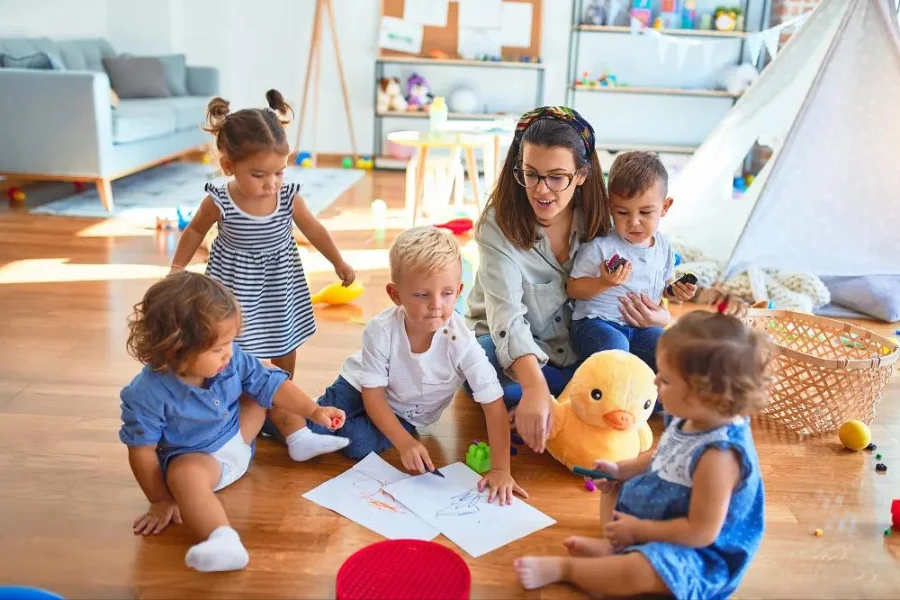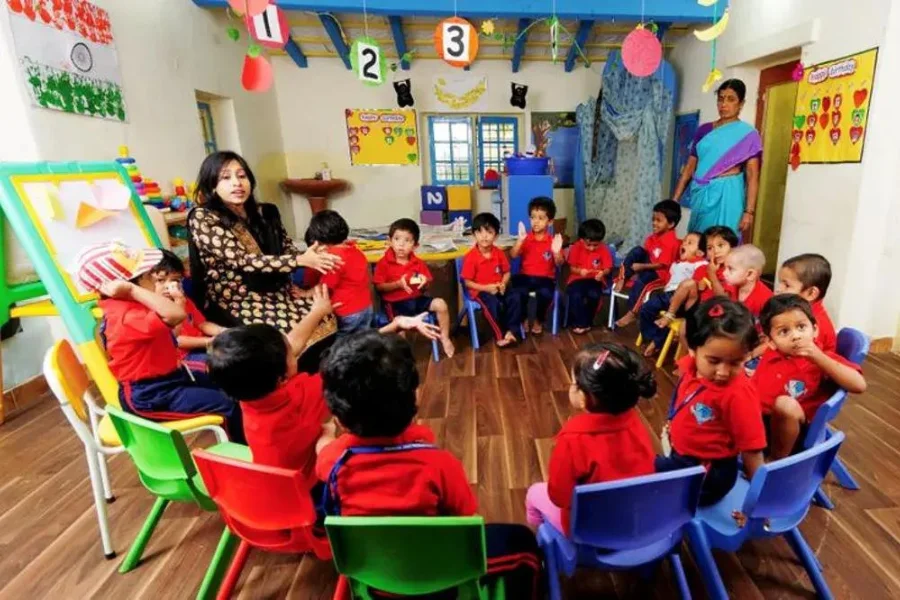Preschool Teacher Lesson Plans

Source: laboriq
Preschool Teacher Lesson Plans
Preschool Teacher Lesson Plans are engaging methods to execute the syllabus of early education effortlessly. It includes activities to offer a fun learning environment to young children. Planning Lesson serves as a structured approach to teach various subjects like math, science, literacy, and creativity. It helps young learners stay focused and develop essential skills. With a well-constructed lesson plan, the educational objectives are achieved, and children receive the best learning experience in preschool.
For more details of ECCE Course Call / Whatsapp on +919869546913 / +919869866277
To download brochure of ECCE Course, Click Here!
Table of Content
What are the Objectives of Preschool Lesson Plan?
The fundamental Early Education Subjects are seamlessly incorporated into the curriculum through engaging Preschool lesson plans. They also provide a structured teaching format for educators. The objectives of a preschool lesson plan focus on the complete growth of children and ensure their academic success.
Let’s explore the vital Objectives of Preschool Lesson Plan:
Social Skills Development
The foremost objective of the lesson plan is to develop skills of communication and collaboration.
Language Integration
With storytelling, reading, and interactive discussions, the verbal skills of children increase. They develop language skills by speaking their imagination related to lessons or stories.
Creative Skills Development
Early Education incorporates lessons that foster the creative skills of young children. They discover their talents and interests through music, dance, and art.
Math Learning
With counting activities included in the lesson plan, children develop a foundation in numeracy knowledge and problem-solving from an early stage.
Emotional Growth
Another crucial objective is to develop early emotions in preschoolers. It helps them to recognize and express feelings healthily, fostering confidence and self-awareness.
Introduce Basic Science Concepts
Lesson plans include basic and simple numeric knowledge that prepares children for future math learning.
Developing Responsibility
It provides opportunities for children to be responsible by following a format or routine, performing certain tasks without any help, and choosing activities according to their interests. This fosters independence and confidence.
Fine and Gross Motor Skills Enhancement
The primary objective is to encourage children’s fine and gross motor muscle strength through enjoyable activities such as coloring, writing, rolling, running, buttoning, and beading.
A thoughtfully planned lesson supports the teaching approach and overall development of young children. It seamlessly provides the purpose of teaching with an organized format to address the different learning needs of preschoolers.

Source: indiadidac
How to Write a Lesson Plan for Early Childhood Education?
Inscribing a lesson plan for preschool children requires creativity and an engaging method to engage them toward academic learning. Certain aspects are crucial to be considered while structuring a lesson plan; these aspects are the following.
Set Clear Objectives
- Preschool Teacher Lesson Plans should be created addressing educational objectives and purposes.
- Focus on crucial skills like language development, social interaction, and fine and motor skills.
Choose a Theme or Topic
- Ensure the theme aligns with developmental goals and keeps children engaged.
- such as seasons, animals, or community helpers.
Plan Engaging Activities
- To support learning and fun, balance structured learning with free play.
Incorporate Multiple Learning Areas
- Blend literacy, math, science, and movement activities into the lesson.
- Use songs, games, and group discussions to make learning interactive.
Prepare Materials in Advance
- Incorporate material that is realistic to the subject taught.
- Ensure materials are harmless and readily available while executing the lesson plan.
Form a Flexible Schedule
- Considering circle time, group activities, and play time, the lesson plan should be executed accordingly.
- Based on children’s needs and interests, make adjustments that fulfill the requirement.
Include Assessment and Reflection
- Regulate lesson plans based on any modification required for better results.
- To evaluate academic progress, conduct regular observation of children.
Early Educators can create a nurturing and appealing learning environment for preschoolers with the help of well-prepared Preschool Teacher Lesson Plans and engaging activities.
What are the Major Parts of Lesson Plan?
A thoughtfully planned lesson provides a clear framework for teachers to execute the purpose of a particular topic to young children. However, creating an effective lesson plan comprises essential aspects that need to be applied efficiently by educators.
Here is the breakdown of the crucial major parts of a Lesson Plan:
Lesson Objectives:
- Lesson to focus on educational purpose and objectives.
- Objectives should be clear, measurable, and age-appropriate.
Materials and Resources
- List all supplies needed, such as books, art materials, or teaching aids.
- To maintain a smooth flow of lessons, ensure materials are ready.
Introduction
- Provide a captivating introduction through rhymes or songs before starting the lesson.
- Make introductions simple and related to the Preschool Teacher Lesson Plans.
Main Activities
- Plan structured activities that align with the learning objectives.
- Include group work, hands-on exploration, and guided instruction.
Assessment or Observation
- Observe how children interact with the lesson and note their progress.
- Ask questions or encourage participation to check understanding.
Conclusion and Reflection
Summarize key points through a brief discussion or review activity. Allow children to speak their thoughts about the lesson taught or activity performed.
For effective teaching and meaningful learning experiences, a well-planned lesson is important. Aspirants looking to enhance their teaching skills, Vidhyanidhi Education Society (Govt. Regd.) is the perfect destination. It offers govt. regd. courses and through their Early Childhood Care and Education Course, enrollees gain in-depth training in lesson planning, child development, and teaching approaches. Through the skillful training in the Early Childhood Care and Education Course, aspirants learn the expertise of curriculum planning and lesson development.
For more details of ECCE Course Call / Whatsapp on +919869546913 / +919869866277
To download brochure of ECCE Course, Click Here!

Sample of Preschool Lesson Plan
Introduction of the Letter ‘E’
Name of the teacher: Riya Mehta
Class/age-group: Nursery / 3–4 years
Subject: English
Topic: Introduction of the letter ‘E’
No. of students in the class: 30
Time limit
The complete session will take about 20 minutes. During this session, I will be working with the children as a group.
Goal to be achieved
To introduce each letter of the alphabet to the children so that they can learn and recognize the letters and items connected to them.
Teaching aids required
Blackboard, chalks, picture book, flashcards, worksheets, crayons.
Introduction of the topic
I will introduce the letter ‘E’ and help the children understand the concept of a new letter by showing them a picture book. I will prepare the book in advance with drawings of Elephant, Egg, Engine, Ear and Eye. The book will be colorful and engaging to attract the children’s attention. I will sit the children in a semi-circle and explain the concept clearly. I will also do a quick revision of previously taught letters.
Execution
My explanation will be as follows:
“Good morning children! Today we will learn a new letter. But first, let’s revise all the letters we have learnt so far.”
(I will write the letters A to D on the blackboard and recite them along with the children.)
Once the revision is done, I will say:
“Today’s letter is ‘E’. ‘E’ says ‘Ehh’ – ‘Ehh’ as in Elephant.”
(I will hold up the picture book and show the front cover with the letter ‘E’ on it.)
I will go through each page of the picture book, naming and showing objects starting with ‘E’.
Then, I will show flashcards with more ‘E’ words and repeat the sounds and names with the children.
Revision
After the explanation, I will give the children a worksheet with objects starting with different letters. I will instruct them to colour only those objects that begin with the letter ‘E’.
This activity will reinforce the concept of the letter ‘E’ and serve as a quick revision.
Shape young minds with our ECCE Course at Vidhyanidhi Education Society. It is your path to a rewarding career!
For more details of ECCE Course Call / Whatsapp on +919869546913 / +919869866277
To download brochure of ECCE Course, Click Here!
FAQs
What are the Benefits of Planning in Early Years?
Planning a good lesson in the early years helps to support the growth of children and incorporate educational objectives in an organized approach.
How do you Learn Lesson Plans?
Teachers learn easily when they thoroughly understand the lesson objective and execute it multiple times.




